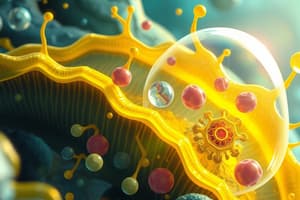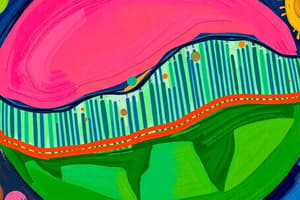Podcast
Questions and Answers
What structures are responsible for intracellular synthesis and transport?
What structures are responsible for intracellular synthesis and transport?
- Endoplasmic Reticulum (correct)
- Golgi Apparatus
- Nucleus
- Ribosomes
What is a eukaryotic animal cell surrounded by?
What is a eukaryotic animal cell surrounded by?
cell membrane with membrane bound structures called organelles
Which of the following is known as the powerhouse of the cell?
Which of the following is known as the powerhouse of the cell?
- Nucleus
- Ribosomes
- Mitochondria (correct)
- Golgi Apparatus
Simple diffusion involves the net movement of substances from low concentration to high concentration.
Simple diffusion involves the net movement of substances from low concentration to high concentration.
What is the function of lysosomes?
What is the function of lysosomes?
Cells absorb molecules by engulfing them, which is called ___.
Cells absorb molecules by engulfing them, which is called ___.
Which process uses energy to transport substances from lower to higher concentration?
Which process uses energy to transport substances from lower to higher concentration?
What element is required for the synthesis of ATP?
What element is required for the synthesis of ATP?
What are the structures called that help with the movement of cells?
What are the structures called that help with the movement of cells?
What is the role of the nucleus in a cell?
What is the role of the nucleus in a cell?
What type of junction keeps solutes from passing between cells in the small intestine?
What type of junction keeps solutes from passing between cells in the small intestine?
What is the function of hydrolase enzymes?
What is the function of hydrolase enzymes?
Connecting cells to form tissues is done through types of ___.
Connecting cells to form tissues is done through types of ___.
Osmosis refers to the diffusion of solutes across a semi-permeable membrane.
Osmosis refers to the diffusion of solutes across a semi-permeable membrane.
Flashcards are hidden until you start studying
Study Notes
Eukaryotic Animal Cell
- Characterized by a cell membrane enclosing membrane-bound organelles.
Cell Membrane
- Composed of a phospholipid bilayer with embedded proteins; may include sugars and lipids.
Proteins in the Cell Membrane
- Serve as recognition markers, facilitate transport across the membrane, and trigger chemical reactions within the cytoplasm.
Functions of the Cell Membrane
- Includes transmembrane proteins that initiate intracellular chemical reactions and maintain the cell's internal environment.
Transport Mechanisms
- Regulates metabolite transport via:
- Simple diffusion
- Carrier-mediated diffusion
- Active transport
- Exocytosis
- Endocytosis (includes phagocytosis and pinocytosis)
- Osmosis
Diffusion Types
- Simple Diffusion: Movement from high to low concentration until equilibrium.
- Carrier-Mediated Diffusion: Specific membrane proteins assist in crossing the membrane.
- Active Transport: Movement against the concentration gradient requiring energy.
Endocytosis Types
- Phagocytosis: Ingestion of large particles.
- Pinocytosis: Ingestion of liquids or small molecules.
Osmosis
- Diffusion of water from high to low concentration across a semi-permeable membrane.
Nucleus
- Houses genetic material and is the site for ribosome synthesis.
- Composed of nuclear membrane, nucleoplasm, and nucleolus.
Ribosome
- Protein production sites formed in the nucleolus, found free-floating or attached to membranes.
Endoplasmic Reticulum (ER)
- Synthesizes and transports materials within the cell:
- Smooth ER: Lipid synthesis.
- Rough ER: Ribosomes attached for protein synthesis.
Golgi Apparatus
- Modifies, stores, and packages proteins from the ER into vesicles for transport via exocytosis.
Lysosome
- Membrane-bound vesicles containing hydrolase enzymes for digesting food and old organelles.
Mitochondria
- Known as the "powerhouse of the cell," responsible for ATP production through aerobic respiration.
Peroxisomes
- Involved in intracellular digestion, regulating hydrogen peroxide levels by breaking it down into water.
Vacuoles
- Fluid-filled spaces for material storage, playing a crucial role in the tonicity of the cytoplasm.
Tonicity & Osmolarity
- Tonicity: Influences osmotic water movement.
- Osmolarity: Total solute concentration in a solution, indicating water availability.
Centrosome
- Contains paired centrioles, acting as a microtubule organizing center during mitosis.
Cytoskeleton
- Network of protein fibers controlling cell shape, movement, and division. Composed of microtubules, microfilaments, and intermediate filaments.
Microtubules
- Hollow protein structures involved in locomotion and chromosome movement during cell division.
Microfilaments
- Actin filaments crucial for muscle contraction and cell motility.
Intermediate Filaments
- Provide mechanical support and anchor the nucleus.
Locomotory Structures
- Mechanisms for animal cell movement include ciliary motion, flagellar motion, and amoeboid motion.
Ciliary Motion
- Hair-like structures (Cilia) create movement; examples include Paramecium.
Cell Connections
- Cells form tissues through connections:
- Tight Junctions: Prevent solute passage between cells.
- Gap Junctions: Allow solute movement and communication between cells.
- Adherens Junctions (Desmosomes): Resist cell separation under stress.
Studying That Suits You
Use AI to generate personalized quizzes and flashcards to suit your learning preferences.




